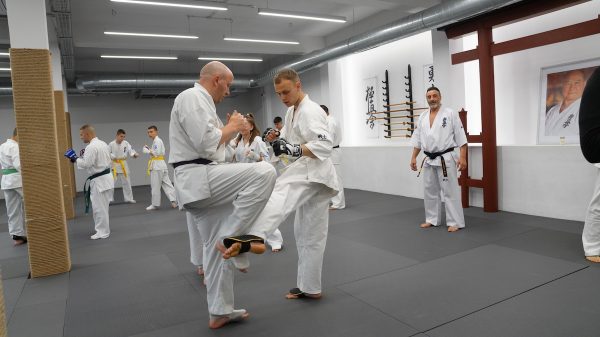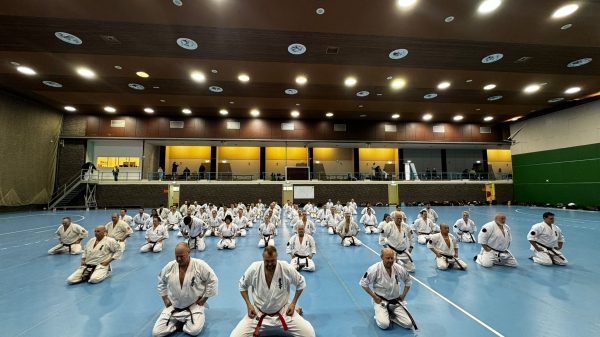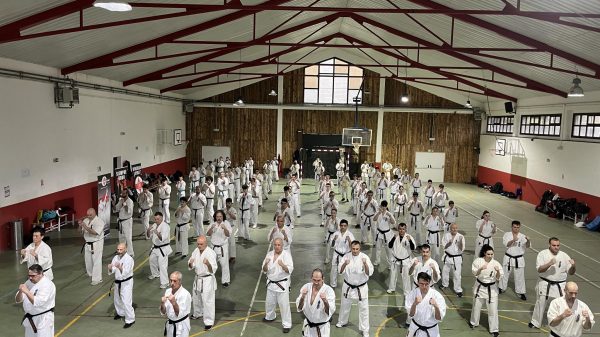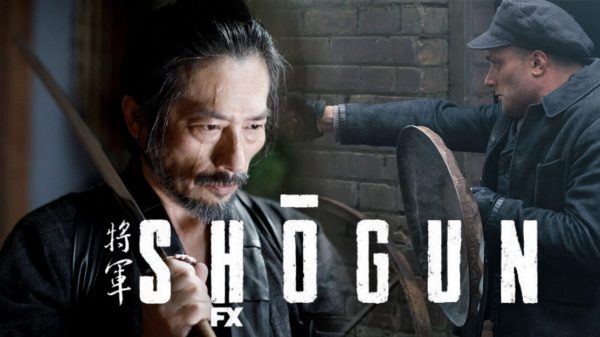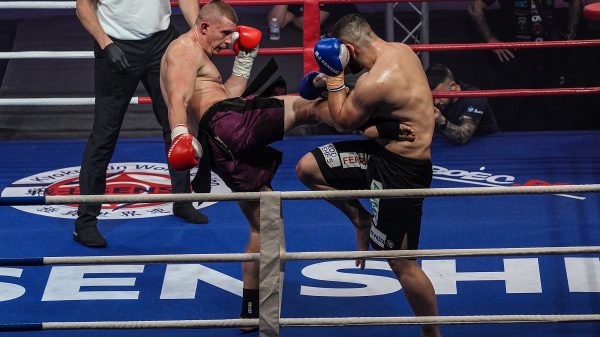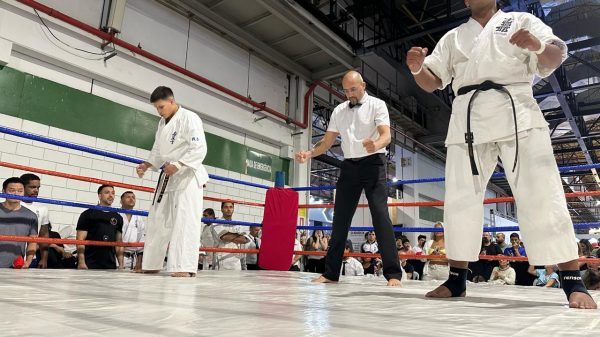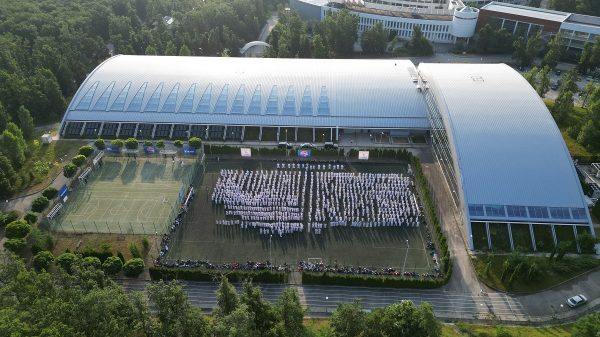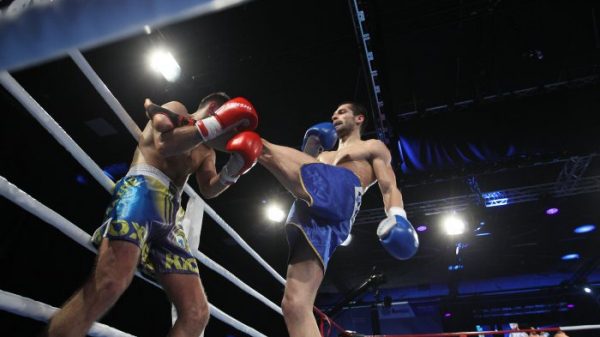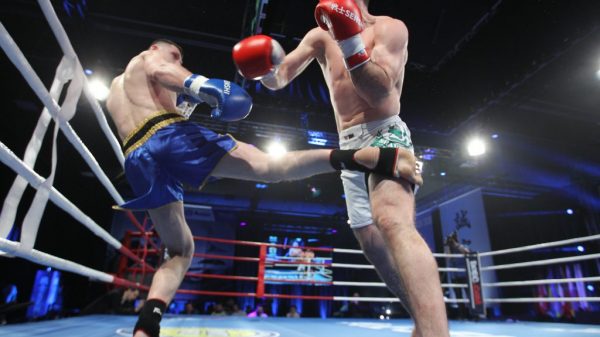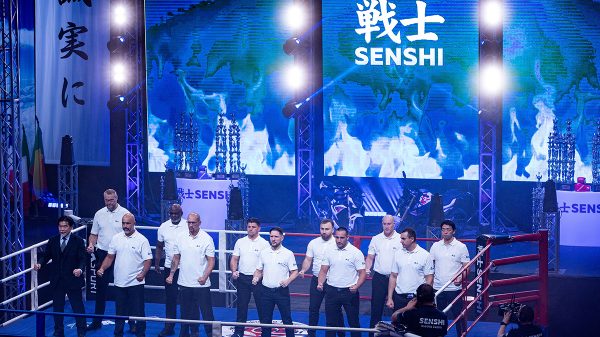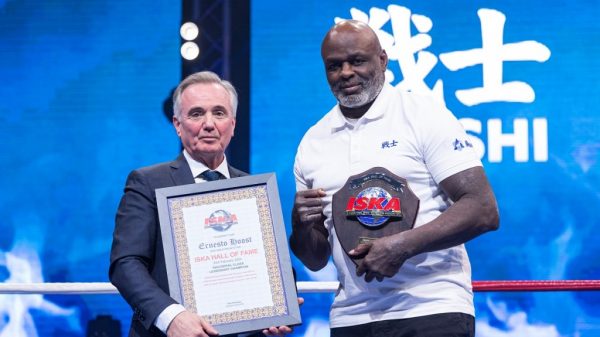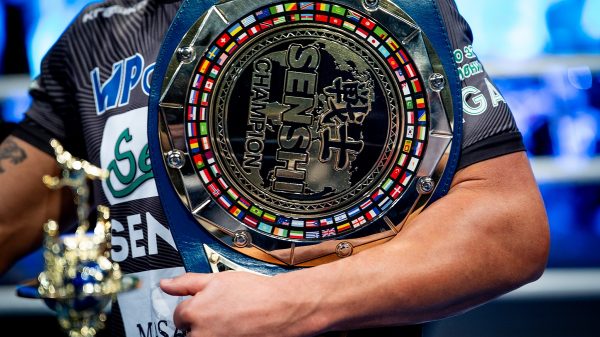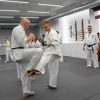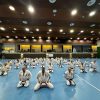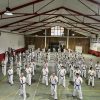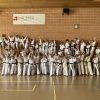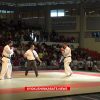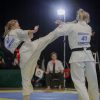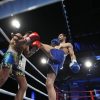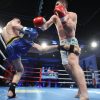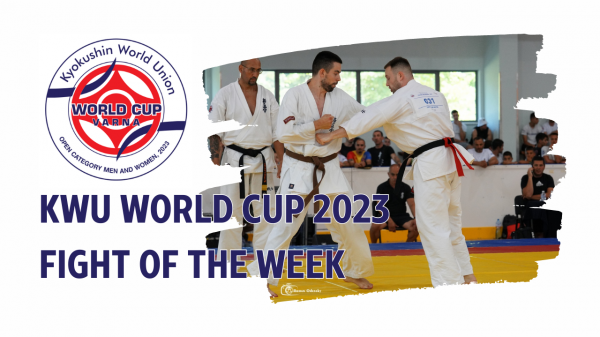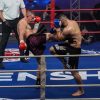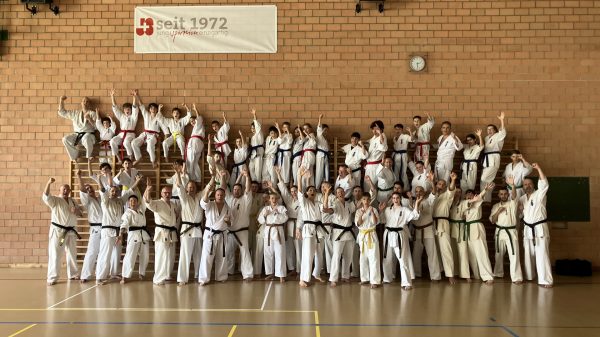Kumite (sparring) is an important aspect of karate training
for kids (and adults) because it gives experience in two critical areas: timing and distance. The full range of karate techniques can be practiced through kata, or prearranged exercises, but kata cannot teach timing or distance. Sparring practice is therefore highly recommended if karate is to be practical for real self-defense, and most kids soon learn to enjoy it.
Sensei works closely with his young students to help them get used to the moving around, the footwork, the straight-line punches (no “haymakers”), the blocking and the strategies used in karate fighting. He also helps them learn the details of point-fighting for tournaments, and the Japanese terminology that referees will use.

As time goes by, each child will begin to learn focus and concentration, and will develop his/her own personal style of moving and fighting, utilizing the basic (and very effective) tools provided by karate. Signing a child up for the occasional private lesson will also give Sensei the opportunity to teach the child some specific techniques tailored to, and compatible with, that child’s own personal body mechanics and movement style.
There’s just one less-than-fun aspect of sparring to consider: if kids spar they’re going to get hit once in a while. Kids getting hit in karate class is (literally) a sensitive subject, and one which both kids and their parents may have some nervous questions about. It seems to present a contradiction: we have our child study self-defense as protection against getting hit in the outside world; so why would we purposely put our child at risk of getting hit in a class? What good can possibly come from it?
These are not questions that only the non-macho, faint-of-heart mothers worry about; I’m a father and I’ve wrung my hands about it as much as anyone. But over the years I’ve gained some good answers, and perhaps sharing what I’ve learned will help to ease the minds of parents as well as their children in class.
First of all let me emphasize that within the dojo only “light” (i.e. non-painful) contact is permitted. You’re supposed to “pull” your punches and kicks when practicing with your classmates, and save the “full contact” for real self-defense situations outside the dojo. This is a critical distinction from the sport of boxing, where the goal is to inflict pain and possibly injury on your opponent. Purposely trying to hit someone hard is against the rules in our dojo – with the exception of koshiki fighting in which the competitors are heavily armored and padded so as to be able to absorb blows painlessly. Of course, occasionally a child will try to break the rule, or more often will accidentally hit too hard; it happens regularly. But in my experience, far fewer kids are actually injured in karate than in baseball, basketball, soccer or football. Supervision is so close, and the rule so unambiguous, that injuries are rare and almost never serious. I don’t think I’ve personally seen any serious injury to a child in the years I’ve been observing classes. (The worst my son has ever suffered was a badly pulled groin muscle from kicking his punching dummy at home before stretching sufficiently.) Tournament competition is another matter, but that is, of course, optional.
The bottom-line goal of karate training is that we want our children to be able to protect themselves against the real-life bad guys out there…the bullies, drug dealers, gang members, muggers and rapists that infest our society and threaten even grade-schoolers. It is important that kids be reminded of this goal. It’s one they can easily appreciate, but can also easily forget.
So, what possible good can it do to occasionally get bopped in the arm, the nose or the breadbasket hard enough to hurt during karate class? Quite a bit, actually:
(1) Kids learn that the momentary pain does not equal serious injury and need not be cause for panic. The first time it happens, they have no way of knowing this, but through experience they come to put it in proper perspective. This is an extremely valuable lesson because kids then learn not to stop fighting when they get hit! They can, of course, get a prompt time-out in class to recover from a hit, but on the street or the playground they won’t be able to. If a bully bops them in the face and they suddenly want to stop fighting and hold their nose, that’s when the bad guy will move in and really let them have it.
Some kids, instead of freezing up in panic when they get hit, will experience an overpowering surge of anger. This can be just as dangerous in a real-life situation because a good fighter must fight smart rather than emotionally; anger blocks thinking, and can cause a person to take foolish risks. Through karate training a child learns to set aside anger and fight with cool calculation, even after having taken a punch.
So the first justification is that a little pain now can save major pain (or worse) later. Panic, anger and shock are transformed by experience into courage, toughness, canniness and “fighting spirit.” Yes, it does work that way…even in the youngest age groups.
(2) The second major lesson kids learn is how to minimize the actual pain of a body hit, when taking a hit cannot be avoided. The worst pain from a hit to the stomach is not from the muscles or skin but from the internal organs absorbing a shock. Tightening up the overlying muscles an instant before the impact creates a wall of protective armor which can absorb the hit with far less pain. Letting out a kiai (yell) is particularly helpful in tensing those muscles. Building trunk muscles, a natural fringe benefit of karate practice, makes this personal armor even more effective. Eventually a child will learn to tighten up instinctively, without even thinking, just before a punch lands.
(3) The third benefit from getting hit in the body is that, all other things being equal, it really does get less painful over time. This phenomenon is not psychological but physical: it’s called “body conditioning.” What happens when a muscle is bruised by a blow is that muscle fibers are separated longitudinally from each other, causing pain. Repeated minor bumps (not even enough to leave a visible bruise) will, over time, cause additional connective collagen fibers to be deposited between the muscle fibers, binding them together more firmly. Subsequent hits do not separate the muscle fibers as easily, and consequently cause less pain and bruising.
The person who can dispense with even trying to block a blow to the stomach in a real fight has a tremendous advantage because he can concentrate all of his weapons (hands and feet) on the counter-attack. Many of the early Okinawan karate masters were of this view, that most blows to the body should be absorbed rather than blocked. Karate training develops a child’s ability to do this effectively, increasing survivability significantly.
So much for self-defense, but what about tournament fighting? Many kids will ultimately want to compete, and test their skills against those of other kids. According to tournament rules, “light contact” is also mandated, and no face contact at all is permitted. So the competitors are just as safe as in their own dojo, right? Not quite.

To enter tournament competition is to accept a much looser definition of exactly what constitutes “light contact” and “excessive contact.” People, including kids, who enjoy tournament fighting generally have a higher tolerance for being hit, especially in the stomach. They expect harder contact, and they hit harder themselves. In fact, although the referees are pretty rigorous about prohibiting and penalizing excessive contact to the head, they tend to permit what amounts to full contact to the body. Their feeling is that a fighter should be in good enough muscular condition to absorb a body blow.
Even under these conditions, however, injuries among children are extremely rare. It’s just a factor of tournament competition to be aware of, and it does add some relatively safe excitement and realism to a match. You wouldn’t want to poke your own classmates in the stomach that hard, or soon you’d have no one left who would want to practice with you. But against strangers in a tournament you need have no such concerns. The feeling of liberation can be exhilarating.
But be warned: most students who are still competing in tournament fighting at the brown and black belt levels actually like being hit—it stimulates their fighting spirit. And the older they get the harder they hit. By the time they reach 17 or 18 years old, the fighting intensity at tournaments has escalated to the point where bloody noses and other injuries are much more common. It’s a risk that must be consciously accepted.
In conclusion, the best approach for a parent to take is to be mildly sympathetic but not overly concerned about routine bumps and bruises their child might receive in class. The dojo is still a friendly environment in which to learn the art of fighting and to gain invaluable experience. If a young child wants to try tournament competition, he or she should be forewarned that it may be a little rougher, but will still not be particularly dangerous relative to other contact sports.
By Wendell E. Wilson (2010)


